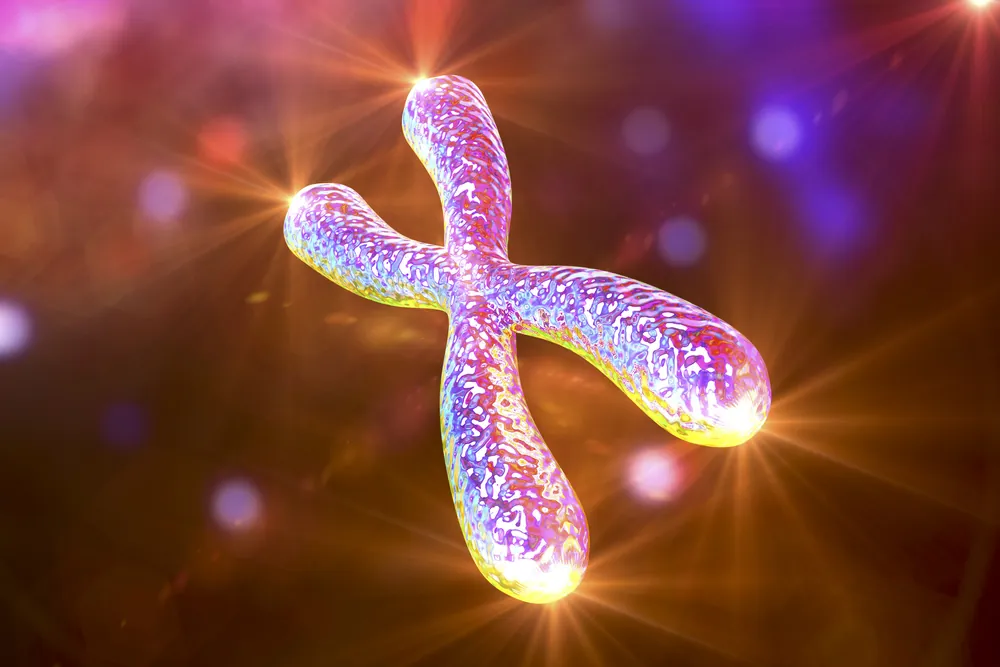A new study published in BMC Psychiatry reviewed literature that links perceived stress during pregnancy with newborns’ telomere length [1].
Lifelong impact of telomere length
Telomeres are protective caps at the end of chromosomes. The shortening of the telomeres, which happens with each DNA replication cycle [2], is one of the Hallmarks of Aging.

Read More
Telomere shortening has been linked to various physical and mental illnesses, such as lung disease [3], infections [4], autoimmune diseases [5], cancer [6], diabetes and metabolic syndrome [7], cardiovascular diseases [8], and psychological disorders [9].
These researchers hypothesize that telomere length later in life can be greatly predicted based on telomere length at birth [10]. Genetic and environmental factors impact telomere length, with psychological stress being one of the key factors [11]. Research on maternal stress and infant telomere length suggested: “that maternal psychological stress during pregnancy may be linked to reduced telomere length in neonates at birth” [12].
That paper was followed by more research on the topic, with some studies obtaining different results [13]. The inconsistency in research results led the authors of this paper to review all the data available on the connection between maternal psychological stress during pregnancy and infant telomere length.
Mothers’ stress and babies’ telomeres
The authors identified eight articles, all from high-income countries, that analyzed a total of 2,955 participants [12-19]. Four qualifying studies with 853 participants were included in the quantitative analysis. The reviewers assessed that based on the Newcastle-Ottawa Quality Assessment Scale, all studies had a low risk of bias and were of good quality.
The analysis of the four quantitative analysis studies revealed a statistically significant inverse relationship between maternal perceived stress and newborn telomere length. However, the researchers noted that not all studies included in their review came to the same conclusion as the meta-analysis.
Among all eight studies, five concluded that there is a clear, significant “negative association between maternal psychological stress during pregnancy” and newborn telomere length. Two other studies didn’t confirm those findings, and another one reported an association in the opposite direction. In that study, maternal stress correlated with longer telomere length in male newborns.
Some, but not all, studies also observed differences between girls and boys, suggesting that further research into sex differences should be performed. Not all studies had representatives of different races, as some included only participants of European descent. However, among those with racial diversity, some studies didn’t observe an association between race/ethnicity and newborn telomere length. Still others observed that perceived maternal stress was associated with shorter newborn telomere length among mothers of European descent.
Some studies also looked at the effect of pre-eclampsia, high blood pressure during pregnancy, on newborn telomere length. While one study didn’t see an effect of preeclampsia on newborn telomere length, another study observed a negative association between preeclampsia in a prior pregnancy and newborn telomere length.
Different studies suggest the role of protective proteins, such as Sirtuin 1, in the placenta on the connection between telomere length and preeclampsia [20].
Limitations and the need for more investigation
This meta-analysis has its limitations, one of which is the limited number of studies that were available for inclusion. The authors also note some heterogeneity within the studies, e.g., differences in the methods used for telomere length measurements, stress measurement tools, and study populations, all made comparisons more challenging. Additionally, the stress measurements were based on self-reported questionnaires, and no biological stress markers were used.
The authors note that since shorter telomeres are linked to developing age-related diseases, and perceived maternal stress seems to impact the telomere length, further studies should address in more detail the exact mechanisms and risk factors for telomere shortening in newborns to address possible ways to reduce the negative effects of stress.
Literature
[1] Moshfeghinia, R., Torabi, A., Mostafavi, S., Rahbar, S., Moradi, M. S., Sadeghi, E., Mootz, J., & Vardanjani, H. M. (2023). Maternal psychological stress during pregnancy and newborn telomere length: a systematic review and meta-analysis. BMC psychiatry, 23(1), 947.
[2] Martens, U. M., Chavez, E. A., Poon, S. S., Schmoor, C., & Lansdorp, P. M. (2000). Accumulation of short telomeres in human fibroblasts prior to replicative senescence. Experimental cell research, 256(1), 291–299.
[3] Birch, J., Barnes, P. J., & Passos, J. F. (2018). Mitochondria, telomeres and cell senescence: Implications for lung ageing and disease. Pharmacology & therapeutics, 183, 34–49.
[4] Noppert, G. A., Feinstein, L., Dowd, J. B., Stebbins, R. C., Zang, E., Needham, B. L., Meier, H. C. S., Simanek, A., & Aiello, A. E. (2020). Pathogen burden and leukocyte telomere length in the United States. Immunity & ageing : I & A, 17(1), 36.
[5] Zeng, Z., Zhang, W., Qian, Y., Huang, H., Wu, D. J. H., He, Z., Ye, D., Mao, Y., & Wen, C. (2020). Association of telomere length with risk of rheumatoid arthritis: a meta-analysis and Mendelian randomization. Rheumatology (Oxford, England), 59(5), 940–947.
[6] Zhang, X., Zhao, Q., Zhu, W., Liu, T., Xie, S. H., Zhong, L. X., Cai, Y. Y., Li, X. N., Liang, M., Chen, W., Hu, Q. S., & Zhang, B. (2017). The Association of Telomere Length in Peripheral Blood Cells with Cancer Risk: A Systematic Review and Meta-analysis of Prospective Studies. Cancer epidemiology, biomarkers & prevention : a publication of the American Association for Cancer Research, cosponsored by the American Society of Preventive Oncology, 26(9), 1381–1390.
[7] Cheng, F., Carroll, L., Joglekar, M. V., Januszewski, A. S., Wong, K. K., Hardikar, A. A., Jenkins, A. J., & Ma, R. C. W. (2021). Diabetes, metabolic disease, and telomere length. The lancet. Diabetes & endocrinology, 9(2), 117–126.
[8] Yeh, J. K., & Wang, C. Y. (2016). Telomeres and Telomerase in Cardiovascular Diseases. Genes, 7(9), 58.
[9] Epel, E. S., & Prather, A. A. (2018). Stress, Telomeres, and Psychopathology: Toward a Deeper Understanding of a Triad of Early Aging. Annual review of clinical psychology, 14, 371–397.
[10] Daniali, L., Benetos, A., Susser, E., Kark, J. D., Labat, C., Kimura, M., Desai, K., Granick, M., & Aviv, A. (2013). Telomeres shorten at equivalent rates in somatic tissues of adults. Nature communications, 4, 1597.
[11] Barragán, R., Ortega-Azorín, C., Sorlí, J. V., Asensio, E. M., Coltell, O., St-Onge, M. P., Portolés, O., & Corella, D. (2021). Effect of Physical Activity, Smoking, and Sleep on Telomere Length: A Systematic Review of Observational and Intervention Studies. Journal of clinical medicine, 11(1), 76.
[12] Entringer, S., Epel, E. S., Lin, J., Buss, C., Shahbaba, B., Blackburn, E. H., Simhan, H. N., & Wadhwa, P. D. (2013). Maternal psychosocial stress during pregnancy is associated with newborn leukocyte telomere length. American journal of obstetrics and gynecology, 208(2), 134.e1–134.e1347.
[13] Ämmälä, A. J., Vitikainen, E. I. K., Hovatta, I., Paavonen, J., Saarenpää-Heikkilä, O., Kylliäinen, A., Pölkki, P., Porkka-Heiskanen, T., & Paunio, T. (2020). Maternal stress or sleep during pregnancy are not reflected on telomere length of newborns. Scientific reports, 10(1), 13986.
[14] Salihu, H. M., King, L. M., Nwoga, C., Paothong, A., Pradhan, A., Marty, P. J., Daas, R., & Whiteman, V. E. (2016). Association Between Maternal-Perceived Psychological Stress and Fetal Telomere Length. Southern medical journal, 109(12), 767–772.
[15] Marchetto, N. M., Glynn, R. A., Ferry, M. L., Ostojic, M., Wolff, S. M., Yao, R., & Haussmann, M. F. (2016). Prenatal stress and newborn telomere length. American journal of obstetrics and gynecology, 215(1), 94.e1–94.e948.
[16] Send, T. S., Gilles, M., Codd, V., Wolf, I., Bardtke, S., Streit, F., Strohmaier, J., Frank, J., Schendel, D., Sütterlin, M. W., Denniff, M., Laucht, M., Samani, N. J., Deuschle, M., Rietschel, M., & Witt, S. H. (2017). Telomere Length in Newborns is Related to Maternal Stress During Pregnancy. Neuropsychopharmacology : official publication of the American College of Neuropsychopharmacology, 42(12), 2407–2413.
[17] Izano, M. A., Cushing, L. J., Lin, J., Eick, S. M., Goin, D. E., Epel, E., Woodruff, T. J., & Morello-Frosch, R. (2020). The association of maternal psychosocial stress with newborn telomere length. PloS one, 15(12), e0242064.
[18] Verner, G., Epel, E., Lahti-Pulkkinen, M., Kajantie, E., Buss, C., Lin, J., Blackburn, E., Räikkönen, K., Wadhwa, P. D., & Entringer, S. (2021). Maternal Psychological Resilience During Pregnancy and Newborn Telomere Length: A Prospective Study. The American journal of psychiatry, 178(2), 183–192.
[19] Bosquet Enlow, M., Petty, C. R., Hacker, M. R., & Burris, H. H. (2021). Maternal psychosocial functioning, obstetric health history, and newborn telomere length. Psychoneuroendocrinology, 123, 105043.
[20] Broady, A. J., Loichinger, M. H., Ahn, H. J., Davy, P. M., Allsopp, R. C., & Bryant-Greenwood, G. D. (2017). Protective proteins and telomere length in placentas from patients with pre-eclampsia in the last trimester of gestation. Placenta, 50, 44–52.



